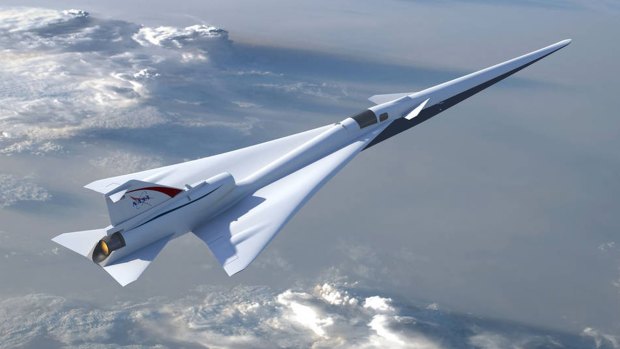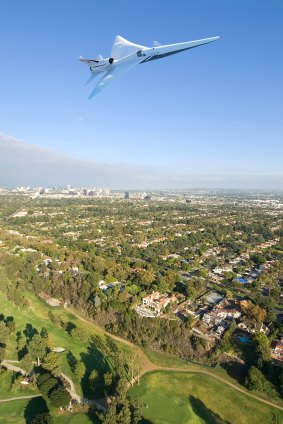By Thomas Black

Lockheed's X-plane will fly at up to 1600 km/h.
Lockheed Martin won a $US247.5 million ($A322 million) NASA contract to build a quieter supersonic jet, a step toward developing planes that can whisk passengers around the globe much more quickly.
The experimental aircraft is expected to take to the skies in 2021 and will have a top velocity of 1.5 times the speed of sound, or about 1600 kilometres per hour at an altitude of 55,000 feet (16,000 metres), Lockheed said Tuesday. While the jet will only have room for a pilot, it will test design principles that soften the sonic boom.
The plane "joins the annals of other historic X-planes in history that have pushed back the frontiers of aviation technology, science, innovation," David Richardson, a director at Lockheed's Skunk Works unit, said at a press conference with NASA in Washington.

The experimental aircraft is expected to take to the skies in 2021.Credit: NASA
The partners are seeking to foster technology that can overcome noise restrictions on supersonic flight, which has been banned overland for civil aircraft since 1973. Once tested for safety, the plane will be ready to fly over select communities to get feedback on the impact. The ultimate goal: opening the skies to faster jet travel and spurring manufacturers to build speedier aircraft.
The Concorde, the supersonic airliner that began service in 1976, was built by a French-British coalition and flown by Air France and British Airways until it was discontinued in 2003 -- in part because noise complaints limited its flights.
Lockheed's experimental plane will be designed to mitigate the shock waves emanating from the nose, wings, engine and other protruding areas of the plane when the sound barrier is broken. The aircraft will use existing parts, such as the landing gear from an F-16 Fighting Falcon and the pilot seat from a T-38 Talon, and will measure 29 metres long with a wing span of nine metres.
"It's about the data that will be collected. It's that data that is used then to shape the future," Richardson said. "We're very confident as we go forward from here in the design that we have, and being able to achieve that low-boom signature."
NASA expects private business jets to be the first type of supersonic aircraft to have commercial success if the ban on overland flight is lifted. Large passenger airliners that break the sound barrier probably won't show up until after 2035, according to NASA's vision.
Aerion Corp., a business jet startup backed by Texas billionaire Robert Bass, is already working on a design that would fly overland just under the speed of sound and then speed up to Mach 1.4 over the ocean. Gulfstream, a unit of General Dynamics, has said it won't attempt to build a supersonic aircraft until it's cleared to fly open-throttle over land and sea.
Boom Technology, a Colorado startup, is developing a supersonic passenger jet with 45 to 55 seats, and attracted a $US10 million investment from Japan Airlines in December.
Lockheed, which makes the F-35 Lightning II fighter jet, helped NASA build a small prototype of the quieter new supersonic plane that was tested in a wind tunnel. Lockheed in December also agreed to help Aerion build its supersonic jet.
Bloomberg
See also: The Boeing supersonic jet that never took off for Qantas
Sign up for the Traveller newsletter
The latest travel news, tips and inspiration delivered to your inbox. Sign up now.